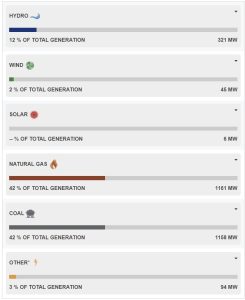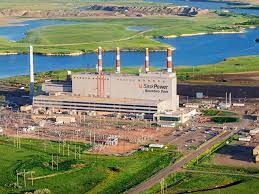While it’s not the same minute-by-minute data provided by the Alberta Electric System Operator for their grid, SaskPower has begun breaking down where its power is coming from on a daily basis. And the data from Oct. 3 and 4 showed wind generated an average of just 7.3 per cent and 6 per cent of its rated capacity of 615 megawatts. On those days, wind provided just 2 and 1 per cent of total power production. And while the Crown corporation often points out that “conventional coal accounts for approximately 24 per cent of SaskPower’s total generation capacity,” on those days, coal was providing an average of 42 per cent of the power in Saskatchewan.
The new webpage can be found here:
The page went live on SaskPower’s webpage on Sept. 21. SaskPower describes it as a “daily snapshot below that’s an average of a 24-hour period.”
On it a person can find out how much each form of power generation, be it coal, natural gas, wind, solar or other provided to the grid on a previous day. Those numbers are averaged for that day, whereas the Alberta Electric System Operator provides minute-by-minute data for each major power generating unit, solar farm, wind farm or battery storage facility. Still, this new page is a substantial increase in the data now being made available to the general public.
Pipeline Online has been pointing out since late December that Alberta posts minute-by-minute data regarding the entire grid, but SaskPower does not. Until recently, SaskPower’s website only said what the current system load was for the entire grid.
SaskPower spokesperson Joel Cherry told Pipeline Online on Oct. 5, “Different people have made it clear that they’d like to see where their power is coming from. I think, for our part, it’s a transparency thing, where we want to educate people where their power is coming from.”
He noted the more detailed information is delayed a day or two. On October 5, the data from Oct. 3 was posted. “That has to do with energy trading, and the potential effects of that, if we share real-time information.”
On May 4 Cherry explained to Pipeline Online, “SaskPower is currently reviewing ways to provide additional information about the grid specifically in terms of renewables generation. The major difference between Alberta and Saskatchewan is Alberta operates a deregulated open market. Saskatchewan’s electric utility is a vertically integrated system that has the responsibility for planning the system expansions to meet domestic demands, maintain system reliability at a stable, reasonable cost rather than the whim of the market. Due to this difference, displaying real-time market sensitive information would put Saskatchewan rate payers at a significant disadvantage when looking for opportunities to supply domestic load over the tie lines during periods of potential internal shortfall due to unforeseen outages or to displace internal generation during times where external market may provide short-term economic options.”
So what does a day of power generation look like in Saskatchewan?
With this new public data, what does power production look like in Saskatchewan? Here’s Monday and Tuesday of this week:
On Monday, Oct. 3, a day when Alberta saw its wind output drop to 0.2 per cent of nameplate capacity, SaskPower’s wind output also suffered.
Across the grid, SaskPower’s demand was an average of 2,666 megawatts. SaskPower and its power purchase agreement partners generated an average of 2,785 megawatts and exported an average of 119 megawatts.
Coal accounted for 42 per cent of total generation, or an average of 1,158 megawatts. Natural gas was almost exactly the same, averaging 1,161 megawatts for 42 per cent.
Notably, although the 139 megawatt Boundary Dam Unit 4 was supposed to have retired back in December, 2021, due to federal regulations requiring the retirement of coal units after 50 years of service, it is still churning out power. That unit has been called back into service several times in 2022, and Cherry confirmed it was in operation as of Oct. 4. But that was expected to change in a week or two. “We brought that facility back online, just to make sure we have a steady supply of power,” he said.
Natural gas is used to backfill renewable power like wind and solar when their intermittency causes a drop in production. And that’s exactly what happened on Oct. 3.

Saskatchewan power production on Oct. 3, 2022. SaskPower
On that day, wind accounted for an average of 45 megawatts of power production. Saskatchewan has eight wind farms attached to the grid. Some are owned and operated by SaskPower, but most are owned and operated by power producers, selling electricity through power purchase agreements.
- Cypress Wind Power Facility (Gull Lake) 11 megawatts, 16 turbines
- Centennial Wind Power Facility (Swift Current) 150 megawatts, 83 turbines
- Morse Wind Power Facility (Morse) 23 megawatts, 10 turbines
- Red Lilly Wind Power Facility (Moosomin) 26 megawatts, 16 turbines
- Western Lily Wind Power Facility (Grenfell) 20 megawatts, 10 turbines
- Riverhurst Wind Facility (Riverhurst) 10 megawatts, 3 turbines
- Golden South Wind Facility (Assiniboia) 200 megawatts, 50 turbines
- Blue Hill Wind Facility (Herbert) 175 megawatts, 35 turbines
The total is 615 megawatts of nameplate capacity across 223 wind turbines across southern Saskatchewan. That means an average of 45 megawatts power production was 7.3 per cent of installed capacity. And that’s the average – not the high or low points during the day. Analysis of Alberta’s grid has shown that power production across their 29 wind farms with 2,734 megawatts has frequently dropped to single digits. It was as low as six megawatts on the same day, Oct. 3.
Wind provided an average of 2 per cent of total power production in Saskatchewan on Oct. 3.
As for solar, it averaged six megawatts for the day. As that’s the average for the day, and the sun doesn’t shine at night, it likely means that actual power production during the day was much higher but averaging it out accounted for the lower number. Comparable solar facilities in Alberta on that day maxed out their power production during the day. Currently there are two solar facilities attached to the grid:
- Highfield Solar Facility (Swift Current) 10 megawatts, 30,000 panels
- Pesâkâstêw Solar Facility (Weyburn) 10 megawatts
Cherry noted that renewables are great for being zero carbon, “but we need to make sure we have baseload sources as well. So, it (the web page) is like an education tool, for us, because obviously those renewables are intermittent and they depend on the weather and everything else on any given day.”
“The good thing about wind obviously is when it’s available, there’s no carbon and it’s very cheap, right? But you can’t rely on it all the time, which is why we have to look at all this other stuff. There’s SMRs (small modular reactors) coming down the pipe and why we’re expanding our partnership, our interconnection with the Southwest Power Pool, etc. So certainly, an important thing for people to understand.”
Wind puts out 6 per cent capacity
On Oct. 4, the numbers were largely the same. Coal produced an average of 1,186 megawatts (42 per cent of total generation), followed by natural gas at an average of 1,163 megawatts (42 per cent). Wind fell to 37 megawatts (1 per cent). Hydro was 315 megawatts (11 per cent) and “other” brought in an average 90 megawatts (3 per cent).
On that day, wind’s average of 37 megawatts was just 6 per cent of its 615 megawatts of nameplate capacity, and 1 per cent of total power production.
The system demand was an average of 2,649 megawatts, while an average of 2,796 megawatts were generated. An average of 147 megawatts were exported.
Conclusions
Finally, Saskatchewan people can see exactly what we’re getting from the massive investments in wind and now solar, and it’s not much at all. While the detail isn’t to the level Alberta provides, it’s a great start. And it allows Saskatchewan people to clearly discuss this whole shift towards “green” renewable power, and if it is actually doing the job it’s being sold as. The answer is “it’s not.”
Analysis of Alberta’s grid over the last 10 months has shown absolutely every megawatt of wind and solar power must be backed up by other generation – usually natural gas. So instead of building one power system composed primarily of consistent, reliable baseload power, with peaking power as need, Canadians are replacing baseload coal power with highly variable, intermittent and unreliable, and then yet another system to back that up. How can building three major generation systems, one of which must be completely redundant of the second, possibly be a wise choice?
And if the federal government is successful in shutting down conventional coal by the end of 2029, and no new nuclear power will be online in Saskatchewan before 2035, what do we do then? This week, two days saw 42 per cent of Saskatchewan’s power come from coal. That’s not a small fraction. It’s the equivalent of supplying every house, hospital and business south of Craven, including Regina.
We need to consider this before we turn off the coal plants and lay off the miners. Without coal, Saskatchewan’s lights would have gone out this past week.
Brian Zinchuk is editor and owner of Pipeline Online, and an occasional contributor to the Frontier Centre for Public Policy. He can be reached at brian.zinchuk@pipelineonline.ca.



